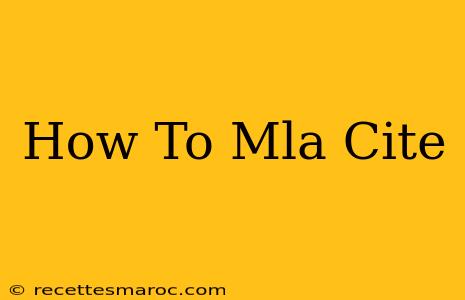MLA (Modern Language Association) citation is a widely used formatting style in academic writing, particularly in the humanities. Knowing how to properly MLA cite your sources is crucial for avoiding plagiarism and demonstrating academic integrity. This guide will walk you through the essentials of MLA citation, covering both in-text citations and the Works Cited page.
Understanding the Importance of MLA Citation
Proper MLA citation is essential for several reasons:
- Avoiding Plagiarism: Accurately citing your sources protects you from accusations of plagiarism, a serious academic offense. It clearly shows which ideas and information belong to others and which are your own original contributions.
- Giving Credit Where Credit is Due: MLA citation gives proper credit to the authors and creators whose work you've used, acknowledging their intellectual contributions.
- Enhancing Credibility: Proper citation enhances the credibility and trustworthiness of your work. It shows you've done your research thoroughly and are presenting information responsibly.
- Allowing Readers to Verify Information: MLA citations provide readers with the information they need to find and verify the sources you used, allowing them to explore the topic further if they choose.
In-Text Citations: Giving Credit Within Your Writing
In-text citations are brief references within your paper that correspond to entries in your Works Cited page. They typically include the author's last name and page number (or other relevant location information).
Basic In-Text Citation Format
The most common format for an in-text citation is:
(Author's Last Name Page Number)
For example:
"The impact of social media on political discourse is a complex issue" (Smith 123).
Variations on In-Text Citations
- Multiple Authors: For two authors, list both last names. For three or more, use the first author's last name followed by "et al." (e.g., (Smith and Jones 45), (Smith et al. 78)).
- No Author: If the author is unknown, use a shortened version of the title in quotation marks (e.g., ("Impact of Social Media" 56)).
- Direct Quotes: Enclose direct quotes in quotation marks and include the page number. For longer quotes (typically four lines or more), use a block quote format.
- Different Source Types: The format might vary slightly depending on the source type (e.g., website, book, journal article).
The Works Cited Page: A Complete List of Your Sources
The Works Cited page is a separate page at the end of your paper that lists all the sources you cited in your writing. Each entry follows a specific format depending on the source type.
Basic Works Cited Entry Elements
Most Works Cited entries include these elements, though the order and specific information may vary:
- Author: The author's name (or names if multiple authors).
- Title: The title of the work (book, article, website, etc.).
- Publication Information: This often includes publisher, publication date, website URL, etc.
Example Works Cited Entries
Here are a few examples of different Works Cited entries:
Book:
Lastname, Firstname. Title of Book. Publisher, Year.
Journal Article:
Lastname, Firstname. "Title of Article." Title of Journal, vol. volume, no. number, year, pages.
Website:
Lastname, Firstname. "Title of Web Page." Name of Website, URL.
Mastering MLA Citation: Resources and Further Help
This guide provides a foundation for MLA citation. However, the specifics can be complex. For comprehensive guidance and the most up-to-date information, consult the official MLA Handbook. Many university libraries and writing centers also offer valuable resources and workshops on MLA citation. Using these resources will ensure your work is accurately and consistently cited.
Remember, consistent and accurate citation is crucial for academic success and ethical scholarship. Take the time to learn the rules and utilize the available resources to master MLA citation. By following these guidelines, you can confidently present your research and avoid any potential issues with plagiarism.

